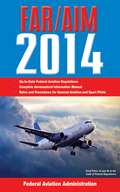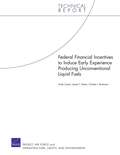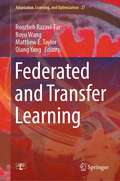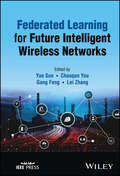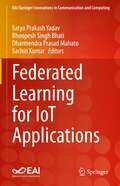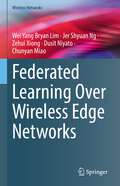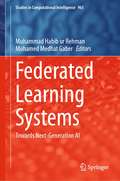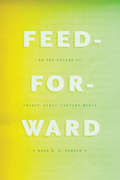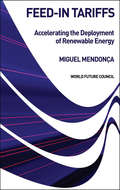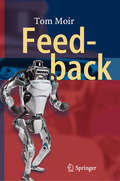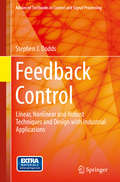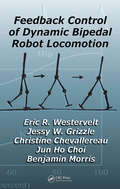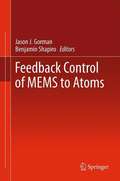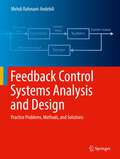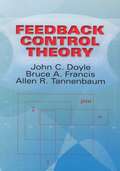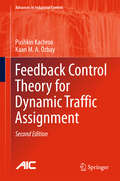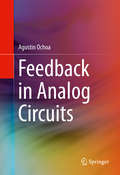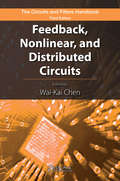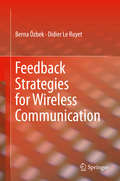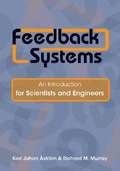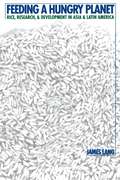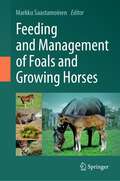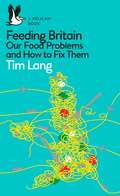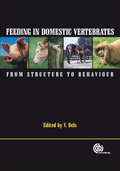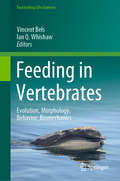- Table View
- List View
Federal Aviation Regulations/Aeronautical Information Manual 2014: Federal Aviation Regulations/aeronautical Information Manual (Far/aim: Federal Aviation Regulations And The Aeronautical Information Manual Ser.)
by Federal Aviation AdministrationIf you’re an aviator or aviation enthusiast, you cannot be caught with an out-of-date edition of the FAR/AIM. In today’s environment, there is no excuse for ignorance of the rules of the US airspace system. In the newest edition of the FAR/AIM, all regulations, procedures, and illustrations are brought up to date to reflect current FAA data. This handy reference book is an indispensable resource for members of the aviation community, as well as for aspiring pilots looking to get a solid background in the rules, requirements, and procedures of flight training. Not only does this manual present all the current FAA regulations, it also includes: A study guide for specific pilot training certifications and ratings A pilot/controller glossary Standard instrument procedures Parachute operations Airworthiness standards for products and parts The NASA Aviation Safety reporting form Important FAA contact informationThis is the most complete guide to the rules of aviation available anywhere. Don’t take off without the FAR/AIM!
Federal Financial Incentives to Induce Early Experience Producing Unconventional Liquid Fuels
by Vi-Nhuan Le Charles J. Bushman James T. Bartis Frank CammThe government, as a principal, may seek to induce a private investor, as anagent, to build and operate an unconventional-oil production plant topromote early production experience with such plants. Facing significantuncertainty about the future, it also wants to limit the cost to the publicof doing this. This report offers an analytic way to design and assesspackages of policy instruments that the government can use to achieve itsgoal.
Federated and Transfer Learning (Adaptation, Learning, and Optimization #27)
by Roozbeh Razavi-Far Boyu Wang Matthew E. Taylor Qiang YangThis book provides a collection of recent research works on learning from decentralized data, transferring information from one domain to another, and addressing theoretical issues on improving the privacy and incentive factors of federated learning as well as its connection with transfer learning and reinforcement learning. Over the last few years, the machine learning community has become fascinated by federated and transfer learning. Transfer and federated learning have achieved great success and popularity in many different fields of application. The intended audience of this book is students and academics aiming to apply federated and transfer learning to solve different kinds of real-world problems, as well as scientists, researchers, and practitioners in AI industries, autonomous vehicles, and cyber-physical systems who wish to pursue new scientific innovations and update their knowledge on federated and transfer learning and their applications.
Federated Learning for Future Intelligent Wireless Networks
by Yao Sun Chaoqun You Gang Feng Lei ZhangFederated Learning for Future Intelligent Wireless Networks Explore the concepts, algorithms, and applications underlying federated learning In Federated Learning for Future Intelligent Wireless Networks, a team of distinguished researchers deliver a robust and insightful collection of resources covering the foundational concepts and algorithms powering federated learning, as well as explanations of how they can be used in wireless communication systems. The editors have included works that examine how communication resource provision affects federated learning performance, accuracy, convergence, scalability, and security and privacy. Readers will explore a wide range of topics that show how federated learning algorithms, concepts, and design and optimization issues apply to wireless communications. Readers will also find: A thorough introduction to the fundamental concepts and algorithms of federated learning, including horizontal, vertical, and hybrid FL Comprehensive explorations of wireless communication network design and optimization for federated learning Practical discussions of novel federated learning algorithms and frameworks for future wireless networks Expansive case studies in edge intelligence, autonomous driving, IoT, MEC, blockchain, and content caching and distribution Perfect for electrical and computer science engineers, researchers, professors, and postgraduate students with an interest in machine learning, Federated Learning for Future Intelligent Wireless Networks will also benefit regulators and institutional actors responsible for overseeing and making policy in the area of artificial intelligence.
Federated Learning for IoT Applications (EAI/Springer Innovations in Communication and Computing)
by Sachin Kumar Satya Prakash Yadav Dharmendra Prasad Mahato Bhoopesh Singh BhatiThis book presents how federated learning helps to understand and learn from user activity in Internet of Things (IoT) applications while protecting user privacy. The authors first show how federated learning provides a unique way to build personalized models using data without intruding on users’ privacy. The authors then provide a comprehensive survey of state-of-the-art research on federated learning, giving the reader a general overview of the field. The book also investigates how a personalized federated learning framework is needed in cloud-edge architecture as well as in wireless-edge architecture for intelligent IoT applications. To cope with the heterogeneity issues in IoT environments, the book investigates emerging personalized federated learning methods that are able to mitigate the negative effects caused by heterogeneities in different aspects. The book provides case studies of IoT based human activity recognition to demonstrate the effectiveness of personalized federated learning for intelligent IoT applications, as well as multiple controller design and system analysis tools including model predictive control, linear matrix inequalities, optimal control, etc. This unique and complete co-design framework will benefit researchers, graduate students and engineers in the fields of control theory and engineering.
Federated Learning Over Wireless Edge Networks (Wireless Networks)
by Wei Yang Lim Jer Shyuan Ng Zehui Xiong Dusit Niyato Chunyan MiaoThis book first presents a tutorial on Federated Learning (FL) and its role in enabling Edge Intelligence over wireless edge networks. This provides readers with a concise introduction to the challenges and state-of-the-art approaches towards implementing FL over the wireless edge network. Then, in consideration of resource heterogeneity at the network edge, the authors provide multifaceted solutions at the intersection of network economics, game theory, and machine learning towards improving the efficiency of resource allocation for FL over the wireless edge networks. A clear understanding of such issues and the presented theoretical studies will serve to guide practitioners and researchers in implementing resource-efficient FL systems and solving the open issues in FL respectively.
Federated Learning Systems: Towards Next-Generation AI (Studies in Computational Intelligence #965)
by Muhammad Habib ur Rehman Mohamed Medhat GaberThis book covers the research area from multiple viewpoints including bibliometric analysis, reviews, empirical analysis, platforms, and future applications. The centralized training of deep learning and machine learning models not only incurs a high communication cost of data transfer into the cloud systems but also raises the privacy protection concerns of data providers. This book aims at targeting researchers and practitioners to delve deep into core issues in federated learning research to transform next-generation artificial intelligence applications. Federated learning enables the distribution of the learning models across the devices and systems which perform initial training and report the updated model attributes to the centralized cloud servers for secure and privacy-preserving attribute aggregation and global model development. Federated learning benefits in terms of privacy, communication efficiency, data security, and contributors’ control of their critical data.
Feed-Forward: On the Future of Twenty-First-Century Media
by Mark B. N. HansenEven as media in myriad forms increasingly saturate our lives, we nonetheless tend to describe our relationship to it in terms from the twentieth century: we are consumers of media, choosing to engage with it. In Feed-Forward, Mark B. N. Hansen shows just how outmoded that way of thinking is: media is no longer separate from us but has become an inescapable part of our very experience of the world. Drawing on the speculative empiricism of philosopher Alfred North Whitehead, Hansen reveals how new media call into play elements of sensibility that greatly affect human selfhood without in any way belonging to the human. From social media to data-mining to new sensor technologies, media in the twenty-first century work largely outside the realm of perceptual consciousness, yet at the same time inflect our every sensation. Understanding that paradox, Hansen shows, offers us a chance to put forward a radically new vision of human becoming, one that enables us to reground the human in a non-anthropocentric view of the world and our experience in it.
Feed-in Tariffs: Accelerating the Deployment of Renewable Energy
by Miguel MendonçaA feed-in tariff is a renewable energy law that obliges energy suppliers to buy electricity produced from renewable resources at a fixed price, usually over a fixed period - even from householders. These legal guarantees ensure investment security, and the support of all viable renewable energy technologies. Supporters argue that the feed-in model, if implemented effectively around the world, would greatly assist the energy revolution that is so desperately required; through CO2 reduction, market creation and development, job creation and improved energy security. Feed-in Tariffs is a concise introduction to feed-in laws, examining the experience of countries that have implemented this model. The author argues that the policy should be implemented anywhere with a suitable national power grid infrastructure, and identifies variations on the policy for those areas without. Alternative models and support schemes are examined to provide policy makers with the information required to consider the implementation of feed-in tariffs, and to introduce the concept to renewable energy technology manufacturers, producers, investors and supporters. With a foreword by Hermann Scheer. Published with the World Future Council.
Feedback
by Tom MoirThis text ventures into areas which the majority of control system books avoid. It was written to look at the area in a much wider form than the usual process control or machine control-systems. Many topics which are covered in other specialities are covered such as the stability of amplifiers, phase-locked loops, structural resonance and parasitic oscillations. It also covers the application and implementation of real-time digital controllers and for the first time the Amplitude-locked loop. An even wider look at the area is shown by examining classical or historic mathematical algorithms in terms of control-theory. Despite its wide range, the book is tutorial in nature and tries to avoid where possible an obtuse mathematical approach. It comes with MATLAB, LabView and a few Mathematica examples. The book is an ideal undergraduate text for engineers and a refresher for many practising engineers. It gives a thorough background in the analogue domain before moving on to digital-control and its applications. The proceeds from author royalties of this book will be donated to charity.
Feedback Control
by Stephen J. DoddsThis book develops the understanding and skills needed to be able to tackle original control problems. The general approach to a given control problem is to try the simplest tentative solution first and, when this is insufficient, to explain why and use a more sophisticated alternative to remedy the deficiency and achieve satisfactory performance. This pattern of working gives readers a full understanding of different controllers and teaches them to make an informed choice between traditional controllers and more advanced modern alternatives in meeting the needs of a particular plant. Attention is focused on the time domain, covering model-based linear and nonlinear forms of control together with robust control based on sliding modes and the use of state observers such as disturbance estimation. Feedback Control is self-contained, paying much attention to explanations of underlying concepts, with detailed mathematical derivations being employed where necessary. Ample use is made of diagrams to aid these conceptual explanations and the subject matter is enlivened by continual use of examples and problems derived from real control applications. Readers' learning is further enhanced by experimenting with the fully-commented MATLAB®/Simulink® simulation environment made accessible at insert URL here to produce simulations relevant to all of the topics covered in the text. A solutions manual for use by instructors adopting the book can also be downloaded from insert URL here. Feedback Control is suitable as a main textbook for graduate and final-year undergraduate courses containing control modules; knowledge of ordinary linear differential equations, Laplace transforms, transfer functions, poles and zeros, root locus and elementary frequency response analysis, and elementary feedback control is required. It is also a useful reference source on control design methods for engineers practicing in industry and for academic control researchers.
Feedback Control of Dynamic Bipedal Robot Locomotion (Automation and Control Engineering #28)
by Eric R. Westervelt Jessy W. Grizzle Christine Chevallereau Jun Ho Choi Benjamin MorrisBipedal locomotion is among the most difficult challenges in control engineering. Most books treat the subject from a quasi-static perspective, overlooking the hybrid nature of bipedal mechanics. Feedback Control of Dynamic Bipedal Robot Locomotion is the first book to present a comprehensive and mathematically sound treatment of feedback design for achieving stable, agile, and efficient locomotion in bipedal robots.In this unique and groundbreaking treatise, expert authors lead you systematically through every step of the process, including:Mathematical modeling of walking and running gaits in planar robotsAnalysis of periodic orbits in hybrid systemsDesign and analysis of feedback systems for achieving stable periodic motionsAlgorithms for synthesizing feedback controllersDetailed simulation examplesExperimental implementations on two bipedal test bedsThe elegance of the authors' approach is evident in the marriage of control theory and mechanics, uniting control-based presentation and mathematical custom with a mechanics-based approach to the problem and computational rendering. Concrete examples and numerous illustrations complement and clarify the mathematical discussion. A supporting Web site offers links to videos of several experiments along with MATLAB® code for several of the models. This one-of-a-kind book builds a solid understanding of the theoretical and practical aspects of truly dynamic locomotion in planar bipedal robots.
Feedback Control of MEMS to Atoms: Feedback Control Of Mems To Atoms (Mems Reference Shelf Ser.)
by Jason J. Gorman Benjamin ShapiroControl from MEMS to Atoms illustrates the use of control and control systems as an essential part of functioning integrated systems. The book is organized according to the dimensional scale of the problem, starting with micro-scale systems and ending with atomic-scale systems. Similar to macro-scale machines and processes, control systems can play a major role in improving the performance of micro- and nano-scale systems and in enabling new capabilities that would otherwise not be possible. However, the majority of problems at these scales present many new challenges that go beyond the current state-of-the-art in control engineering. This is a result of the multidisciplinary nature of micro/nanotechnology, which requires the merging of control engineering with physics, biology and chemistry.
Feedback Control Systems Analysis and Design: Practice Problems, Methods, and Solutions
by Mehdi Rahmani-AndebiliThis study guide is designed for students taking courses in feedback control systems analysis and design. The textbook includes examples, questions, and exercises that will help electrical engineering students to review and sharpen their knowledge of the subject and enhance their performance in the classroom. Offering detailed solutions, multiple methods for solving problems, and clear explanations of concepts, this hands-on guide will improve student’s problem-solving skills and basic and advanced understanding of the topics covered in these courses.
Feedback Control Theory (Dover Books on Electrical Engineering)
by Allen R. Tannenbaum John C. Doyle Bruce A. FrancisAn excellent introduction to feedback control system design, this book offers a theoretical approach that captures the essential issues and can be applied to a wide range of practical problems. Its explorations of recent developments in the field emphasize the relationship of new procedures to classical control theory, with a focus on single input and output systems that keeps concepts accessible to students with limited backgrounds. The text is geared toward a single-semester senior course or a graduate-level class for students of electrical engineering.The opening chapters constitute a basic treatment of feedback design. Topics include a detailed formulation of the control design program, the fundamental issue of performance/stability robustness tradeoff, and the graphical design technique of loopshaping. Subsequent chapters extend the discussion of the loopshaping technique and connect it with notions of optimality. Concluding chapters examine controller design via optimization, offering a mathematical approach that is useful for multivariable systems.
Feedback Control Theory for Dynamic Traffic Assignment (Advances in Industrial Control)
by Kaan M.A. Özbay Pushkin KachrooThis book develops a methodology for designing feedback control laws for dynamic traffic assignment (DTA) exploiting the introduction of new sensing and information-dissemination technologies to facilitate the introduction of real-time traffic management in intelligent transportation systems. Three methods of modeling the traffic system are discussed:partial differential equations representing a distributed-parameter setting;continuous-time ordinary differential equations (ODEs) representing a continuous-time lumped-parameter setting; anddiscreet-time ODEs representing a discrete-time lumped-parameter setting.Feedback control formulations for reaching road-user-equilibrium are presented for each setting and advantages and disadvantage of using each are addressed. The closed-loop methods described are proposed expressly to avoid the counter-productive shifting of bottlenecks from one route to another because of driver over-reaction to routing information.The second edition of Feedback Control Theory for Dynamic Traffic Assignment has been thoroughly updated with completely new chapters:a review of the DTA problem and emphasizing real-time-feedback-based problems;an up-to-date presentation of pertinent traffic-flow theory; anda treatment of the mathematical solution to the traffic dynamics.Techinques accounting for the importance of entropy are further new inclusions at various points in the text.Researchers working in traffic control will find the theoretical material presented a sound basis for further research; the continual reference to applications will help professionals working in highway administration and engineering with the increasingly important task of maintaining and smoothing traffic flow; the extensive use of end-of-chapter exercises will help the graduate student and those new to the field to extend their knowledge.
Feedback in Analog Circuits
by Agustin OchoaThis book describes a consistent and direct methodology to the analysis and design of analog circuits with particular application to circuits containing feedback. The analysis and design of circuits containing feedback is generally presented by either following a series of examples where each circuit is simplified through the use of insight or experience (someone else's), or a complete nodal-matrix analysis generating lots of algebra. Neither of these approaches leads to gaining insight into the design process easily. The author develops a systematic approach to circuit analysis, the Driving Point Impedance and Signal Flow Graphs (DPI/SFG) method that does not require a-priori insight to the circuit being considered and results in factored analysis supporting the design function. This approach enables designers to account fully for loading and the bi-directional nature of elements both in the feedback path and in the amplifier itself, properties many times assumed negligible and ignored. Feedback circuits are shown to be directly and completely handled with little more effort than that for open loop designs. · Enables deep, functional understanding of feedback in analog circuits; · Describes a new, systematic approach to circuit analysis using Driving Point Impedance and Signal Flow Graphs (DPI/SFG); · Includes corrections to both the 'opening the loop' and Bode Return Ratio Methods.
Feedback, Nonlinear, and Distributed Circuits (The Circuits and Filters Handbook, 3rd Edition)
by Wai-Kai ChenUpon its initial publication, the Handbook of Circuits and Filters broke new ground. It quickly became the resource for comprehensive coverage of issues and practical information that can be put to immediate use. Not content to rest on his laurels, editor Wai-kai Chen divided the second edition into volumes, making the information easily accessible and digestible. In the third edition, these volumes have been revised, updated, and expanded so that they continue to provide solid coverage of standard practices and enlightened perspectives on new and emerging techniques. Feedback, Nonlinear, and Distributed Circuits draws together international contributors who discuss feedback amplifier theory and then move on to explore feedback amplifier configurations. They develop Bode’s feedback theory as an example of general feedback theory. The coverage then moves on to the importance of complementing numerical analysis with qualitative analysis to get a global picture of a circuit’s performance. After reviewing a wide range of approximation techniques and circuit design styles for discreet and monolithic circuits, the book presents a comprehensive description of the use of piecewise-linear methods in modeling, analysis, and structural properties of nonlinear circuits highlighting the advantages. It describes the circuit modeling in the frequency domain of uniform MTL based on the Telegrapher’s equations and covers frequency and time domain experimental characterization techniques for uniform and nonuniform multiconductor structures. This volume will undoubtedly take its place as the engineer's first choice in looking for solutions to problems encountered in the analysis and behavior predictions of circuits and filters.
Feedback Strategies for Wireless Communication
by Berna Özbek Didier Le RuyetThis book explores the different strategies regarding limited feedback information. The book analyzes the impact of quantization and the delay of CSI on the performance. The author shows the effect of the reduced feedback information and gives an overview about the feedback strategies in the standards. This volume presents theoretical analysis as well as practical algorithms for the required feedback information at the base stations to perform adaptive resource algorithms efficiently and mitigate interference coming from other cells.
Feedback Systems: An Introduction for Scientists and Engineers
by Karl Johan Aström Richard M. Murray<p>This book provides an introduction to the mathematics needed to model, analyze, and design feedback systems. It is an ideal textbook for undergraduate and graduate students, and is indispensable for researchers seeking a self-contained reference on control theory. Unlike most books on the subject, Feedback Systems develops transfer functions through the exponential response of a system, and is accessible across a range of disciplines that utilize feedback in physical, biological, information, and economic systems. <p>Karl Åström and Richard Murray use techniques from physics, computer science, and operations research to introduce control-oriented modeling. They begin with state space tools for analysis and design, including stability of solutions, Lyapunov functions, reachability, state feedback observability, and estimators. The matrix exponential plays a central role in the analysis of linear control systems, allowing a concise development of many of the key concepts for this class of models. Åström and Murray then develop and explain tools in the frequency domain, including transfer functions, Nyquist analysis, PID control, frequency domain design, and robustness. They provide exercises at the end of every chapter, and an accompanying electronic solutions manual is available. Feedback Systems is a complete one-volume resource for students and researchers in mathematics, engineering, and the sciences. <p> <li>Covers the mathematics needed to model, analyze, and design feedback systems <li>Serves as an introductory textbook for students and a self-contained resource for researchers <li>Includes exercises at the end of every chapter <li>Features an electronic solutions manual <li>Offers techniques applicable across a range of disciplines</li>
Feeding a Hungry Planet
by James LangRice is the food crop the world depends on most. In Feeding a Hungry Planet, James Lang demonstrates how research has benefited rice growers and increased production. He describes the life cycle of a rice crop and explains how research is conducted and how the results end up growing in a farmer's field. Focusing on Asia and Latin America, Lang explores lowland and upland rice systems, genetics, sustainable agriculture, and efforts to narrow the gap between yields at research stations and those on working farms. Ultimately, says Lang, the ability to feed growing populations and protect fragile ecologies depends as much on the sustainable on-site farm technologies as on high-yielding crop varieties. Lang views agriculture as a chain of events linking the farmer's field with the scientist's laboratory, and he argues that rice cultivation is shaped by different social systems, cultures, and environments. Describing research conducted by the International Rice Research Institute in the Philippines and by the International Center for Tropical Agriculture in Colombia, he shows how national programs tailor research to their own production problems. According to Lang, the interaction of research programs, practical problem solving, and local extension efforts suggests a new model for international development.
Feeding and Management of Foals and Growing Horses
by Markku SaastamoinenThis volume offers the latest research-based findings to equip professionals involved in the breeding and raising of horses. Contributions were carefully selected and prepared by leading experts in their fields. The collection starts with a discussion of pregnant and lactating mares, followed by details on foal development, nutritional requirements, and feeding practices under different conditions. Special sections on young horses in training, parasite control as well as on health risks related to nutrition and exercise round off this unique and easy-to-read reference.Today’s horses perform variety of roles and there are many categories of horses based on their breed, size and use, making adequate nutrition challenging. This book considers the links between health, proper dietary treatment and management practices to increase our understanding of the needs of growing horses. In addition, it highlights various innovations in equine nutrition and management to ensure animal wellbeing.Veterinarians, animal nutritionist, and all stakeholders and people working in the horse industry will benefit from the presented knowledge. This book fills a literature gap to prevent health consequences and strengthen performance and physical development in equines.
Feeding Britain: Our Food Problems and How to Fix Them (Pelican Books)
by Tim LangHow does Britain get its food? Why is our current system at breaking point?How can we fix it before it is too late?British food has changed remarkably in the last half century. As we have become wealthier and more discerning, our food has Europeanized (pizza is children's favourite food) and internationalized (we eat the world's cuisines), yet our food culture remains fragmented, a mix of mass 'ultra-processed' substances alongside food as varied and good as anywhere else on the planet.This book takes stock of the UK food system: where it comes from, what we eat, its impact, fragilities and strengths. It is a book on the politics of food. It argues that the Brexit vote will force us to review our food system. Such an opportunity is sorely needed. After a brief frenzy of concern following the financial shock of 2008, the UK government has slumped once more into a vague hope that the food system will keep going on as before. Food, they said, just required a burst of agri-technology and more exports to pay for our massive imports.Feeding Britain argues that this and other approaches are short-sighted, against the public interest, and possibly even strategic folly. Setting a new course for UK food is no easy task but it is a process, this book urges, that needs to begin now.'Tim Lang has performed a public service' Simon Jenkins, Sunday Times
Feeding in Domestic Vertebrates: From Structure to Behaviour
by V. BelsAimed at advanced students and researchers, this volume reviews current knowledge about feeding in domestic vertebrates. Early chapters outline the feeding structures and mechanisms of mammals and birds. Subsequent chapters discuss feeding behavior in particular species, such as chickens, pigs, rabbits, horses, herbivores, ruminants, and even ostriches. Feeding issues relating to free-range poultry and pigs are also addressed. Editor Bels is affiliated with the Muséum National d'Histoire Naturelle in Paris. Distributed in the U. S. by Oxford U. Press. Annotation ©2007 Book News, Inc. , Portland, OR (booknews. com)
Feeding in Vertebrates: Evolution, Morphology, Behavior, Biomechanics (Fascinating Life Sciences)
by Ian Q. Whishaw Vincent BelsThis book provides students and researchers with reviews of biological questions related to the evolution of feeding by vertebrates in aquatic and terrestrial environments. Based on recent technical developments and novel conceptual approaches, the book covers functional questions on trophic behavior in nearly all vertebrate groups including jawless fishes. The book describes mechanisms and theories for understanding the relationships between feeding structure and feeding behavior. Finally, the book demonstrates the importance of adopting an integrative approach to the trophic system in order to understand evolutionary mechanisms across the biodiversity of vertebrates.
